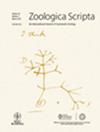鲯鳅(鸟类:伪ocolopteryx)的生物地理学、物种和生态位演化
IF 2
2区 生物学
Q2 EVOLUTIONARY BIOLOGY
引用次数: 0
摘要
生态和地理因素决定了物种目前的分布。在系统发育框架中分析它们之间的相互作用,是了解形成一个类群进化的历史过程的关键。在这里,我们模拟了五种鲯鳅(Pseudocolopteryx spp.)的生态位和地理分布,在系统发生学框架下研究它们的生物地理历史、生态位演化和物种演化过程。我们的潜在分布模型揭示了多拉迪鸟在整个分布区的新分布模式和季节性运动,其中四个物种具有明显的繁殖和非繁殖洄游分布,一个物种(P. sclateri)表现出复杂的时空分布,表明其具有游牧性。生态位配对比较表明,没有一种鲯鳅具有相同的生态位,生态位差异是由于物种对特定栖息地的偏好造成的。系统发育加权地理和生态分析表明,在多拉迪托鱼的进化过程中存在同域物种和生态位易变的模式。P. sclateri的分化似乎与其从热带到温带的湿地特化有关。山地P. acutipennis在物种分化后扩展到了人类改造的低地,这突出了在生态位比较中控制物种分化后变化的必要性。反过来,P. dinelliana、P. citreola和P. flaviventris基本上表现出异地繁殖分布,这是在其物种形成过程中环境介导分化的产物。最近分化出的隐性姊妹物种P. citreola和P. flaviventris的分布和迁移数据符合两种可能的物种分化情况:同域物种分化和迁移定量物种分化。本文章由计算机程序翻译,如有差异,请以英文原文为准。
Biogeography, speciation and niche evolution of doraditos (Aves: Pseudocolopteryx)
Ecological and geographical factors shape the current distribution of species. Analysing their interplay in a phylogenetic framework is key to understand the historical processes that have shaped the evolution of a group. Here, we modelled the ecological niches and geographic distributions of the five species of doraditos (Pseudocolopteryx spp.) to study their biogeographic histories, niche evolution and speciation process in a phylogenetic framework. Our potential distribution models uncovered novel range‐wide distributional patterns and seasonal movements in the doraditos, where four species are migratory with distinct breeding and non‐breeding distributions, and one (P. sclateri ) exhibits a complex spatiotemporal distribution indicating nomadism. Ecological niche pairwise comparisons showed that none of the doraditos have equivalent niches and that niche differences are due to species‐specific habitat preferences. Phylogenetically weighted geographical and ecological analyses showed patterns of allopatric speciation and niche lability in the evolution of doraditos. The divergence of P. sclateri seems tied to its tropical‐to‐temperate wetland specialization. The montane P. acutipennis expanded to human‐modified lowlands following speciation, highlighting the need to control for post‐speciational changes in ecological niche comparisons as done here. In turn, P. dinelliana , P. citreola and P. flaviventris showed essentially allopatric breeding distributions, as a product of environmentally mediated divergence during their speciation processes. The distribution and migration data of the recently diverged cryptic sister species P. citreola and P. flaviventris are consistent with two possible speciation scenarios: peripatric speciation and migration dosing speciation.
求助全文
通过发布文献求助,成功后即可免费获取论文全文。
去求助
来源期刊

Zoologica Scripta
生物-动物学
CiteScore
5.60
自引率
0.00%
发文量
52
审稿时长
>12 weeks
期刊介绍:
Zoologica Scripta publishes papers in animal systematics and phylogeny, i.e. studies of evolutionary relationships among taxa, and the origin and evolution of biological diversity. Papers can also deal with ecological interactions and geographic distributions (phylogeography) if the results are placed in a wider phylogenetic/systematic/evolutionary context. Zoologica Scripta encourages papers on the development of methods for all aspects of phylogenetic inference and biological nomenclature/classification.
Articles published in Zoologica Scripta must be original and present either theoretical or empirical studies of interest to a broad audience in systematics and phylogeny. Purely taxonomic papers, like species descriptions without being placed in a wider systematic/phylogenetic context, will not be considered.
 求助内容:
求助内容: 应助结果提醒方式:
应助结果提醒方式:


